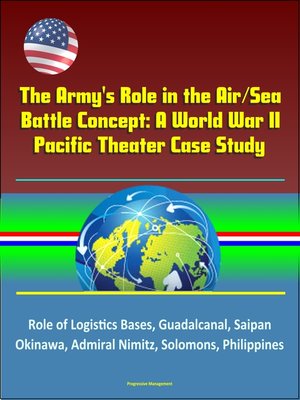The Army's Role in the Air/Sea Battle Concept
ebook ∣ A World War II Pacific Theater Case Study--Role of Logistics Bases, Guadalcanal, Saipan, Okinawa, Admiral Nimitz, Solomons, Philippines
By Progressive Management

Sign up to save your library
With an OverDrive account, you can save your favorite libraries for at-a-glance information about availability. Find out more about OverDrive accounts.
Find this title in Libby, the library reading app by OverDrive.



Search for a digital library with this title
Title found at these libraries:
| Library Name | Distance |
|---|---|
| Loading... |
Professionally converted for accurate flowing-text e-book format reproduction, this unique book uses a case study of World War II Pacific theater logistics and basing to evaluate the Army's role in the air/sea battle concept.
With the end of the Iraq War and drawdown in Afghanistan, the United States (U.S.) is shifting strategic focus to the Pacific Ocean and countries therein. Reliant on its carrier fleet and air power for power projection, the U.S. envisions a future combat environment where a belligerent nation attempts to prevent these forces from success, through anti-access and area-denial strategies. This concept is formulated into the Air/Sea Battle concept, which relies on U.S. technological advantages to ensure access. The strategy does not adequately address the logistical needs of the joint services, nor does it account for increasing lethality in ballistic anti-ship missile technology. Improved capabilities in anti-ship ballistic missiles increase the range from which a carrier group can safely operate, placing greater importance on ground based aircraft and bases. The U.S. Army's role in Air/Land Battle is to establish and defend numerous Pacific bases and support naval/air forces, prior to decisive action.







